The One and Only Julekalender Posted by Bjørn A. Bojesen on Dec 20, 2011 in Culture
”What was that? That was what!” the nisse Günther exclaims, his face dripping with the water splashed on him by fellow nisser Fritz and Hansi in an attempt to cure him from his momentary belief he’s a German tracker dog. The scene appears in The Julekalender, a televised ”Christmas calendar” in the Danish broadcasting tradition, with a story split in 24 parts and shown every day from December 1st to December 24th, the day julen (the Christmas) is usually celebrated in Denmark. The Julekalender premiered on December 1st, 1991, and had a considerable part of all Danes tune in on the channel TV2 every evening in order to see the daily afsnit (episode). The series was so popular that some of its idioms even entered the common language! (Such as the character Benny’s bob-bob-bob – uttered while wagging a downturned palm as a reaction to a situation you’re not wholly comfortable with…)
The Danes may laugh, but here the humour needs some explanation… A nisse is a kind of Scandinavian pixy. Nisser wear red hue|r (cap|s) and eat risengrød (rice porridge). They look a lot like Santa Claus, only without the reindeer and the silly laugh. (Of course, we’d say the Americans got it all wrong!)
The nisser of The Julekalender are out of the ordinary in that they speak a strange mixture of English and Danish – or rather, of English and a kind of do-it-yourself Western Jutlandic dialect. Much of the humour of the series is based on this linguistic interplay. In a way it is parodying the way many state-of-the-art Danes constantly switch between Danish and English… (The title itself is a prominent example of this; in ”pure” Danish it should be Julekalenderen with the Danish article -en.) ”What was that? That was what!” becomes hilarious when you know that vådt – pronounced ’wot’ by the nisse – is the neuter of våd ’wet’. ”What was that? That was wet!”
A recap for starters:
The three nisser Fritz, Hansi and Günther are on a quest for a key to the ”playdose” (in Danish: spilledåse) – the musical box that keeps the old nisse Gammel Nok (”Old Enough”) alive. While flying over Western Jutland in a vintage aircraft, their engine crashes in the vicinity of the potato farm of Oluf and Gertrud Sand and their dog Emil. The nisser hide in an underground hule (cave) in the forest while trying to get the plane back on its wings. The farmer couple go on with their somewhat ridiculously monotone and lazy everyday life without having the slightest idea of the supernatural presence in the woods next door. One day Benny knocks on their door, presenting himself as a salesman from Copenhagen. With his loud, talkative city manners he could hardly be more alien to the farmers; yet somehow he manages to fool them into giving him accomodation on their sofa… But there’s something weird going on… For some reason, the very word ’nisse’ makes him go off the deep end…
The Julekalender is a modern milestone in the Danish humorous tradition; it has gone on the air six times – most recently this December – and in has been recreated in Norway and Finland. The script was written by the musician trio De Nattergale, who also play all the roles – except Gammel Nok and the dog Emil. It can be no surprise, then, that there’s a lot of music in the series… Hits like ”The Støvledance” and ”It’s hard to be a nissemand” are still floor-burners at Danish Christmas parties.
http://www.youtube.com/watch?v=NXcPrbgPH1s
”It’s hard to be a nissemand”

Build vocabulary, practice pronunciation, and more with Transparent Language Online. Available anytime, anywhere, on any device.
About the Author: Bjørn A. Bojesen
I was born in Denmark, but spent large parts of my childhood and study years in Norway. I later returned to Denmark, where I finished my MA in Scandinavian Studies. Having relatives in Sweden as well, I feel very Scandinavian! I enjoy reading and travelling, and sharing stories with you! You’re always welcome to share your thoughts with me and the other readers.




